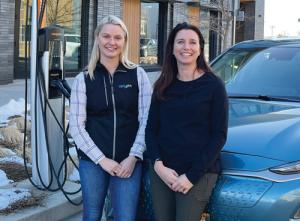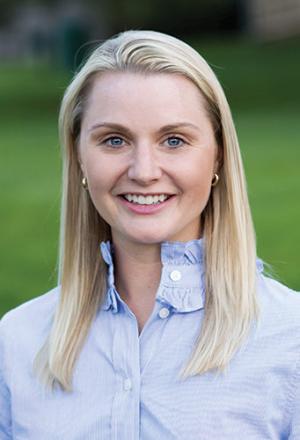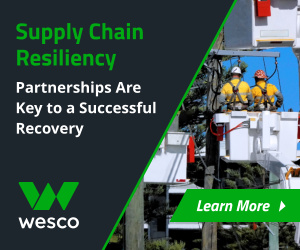EV Innovation
Erin D’Amato is Director, Innovation Solutions at Uplight. Katie Parkinson is VP of Utility Services at Rolling Energy Resources.
The perfect recipe to get utilities driving in the right electric vehicle direction has been found by combining the skills of two clean-energy transformation companies. Mix together innovative software, vehicle telematics, and EV charging expertise, combined with experience in demand side management and demand response, throw in data and voilà, it's the perfect creation for extending the reach of EV load management programs to utilities and customers everywhere.

How the formula came together sounds simple, but as with all new endeavors, there was a lot more to it. A large part of being in the creative kitchen involves teaching customers and using behavioral interventions, perhaps incentives, the carrot.
Public Utilities Fortnightly's Steve Mitnick discussed with these innovators, Uplight's Erin D'Amato and Rolling Energy Resources' Katie Parkinson, how they are bringing the future here now. This customer journey involves apps too, just not the kind you eat.
PUF's Steve Mitnick: Katie, your company and Uplight are partnering in one of the most critical areas of the energy transformation. Talk about that.
Katie Parkinson: Rolling Energy Resources (RER), combined with Uplight, is extending the reach of EV load management programs to utilities and customers all over the country. It's our innovative software combined with Uplight's reach, customer service, and connections.
 Erin D’Amato: By having a more integrated experience with OEMs, but also helping the utility create a brand with outbound communications such as emails with utility branding, we’re helping customers connect the dots of why and when they should charge their vehicle. Their utility cares about that for balancing grid demand.
Erin D’Amato: By having a more integrated experience with OEMs, but also helping the utility create a brand with outbound communications such as emails with utility branding, we’re helping customers connect the dots of why and when they should charge their vehicle. Their utility cares about that for balancing grid demand.
PUF: Erin, talk about why Uplight thought this software is too important to pass up.
Erin D'Amato: Uplight has many years of experience in device management with smart thermostats and water heaters, and for EVs, we've ventured into direct integrations with Level two chargers. In order to have a direct vehicle integration with vehicle telematics, we went through an intensive process to determine who we wanted to partner with.
RER has the best-in-class vehicle telematics service and software. It was a no-brainer for us to partner with them because of their coverage and deep utility expertise.
PUF: What makes this software distinctive and ready for the massive need out there?
 Katie Parkinson: When we connect to the vehicle, we collect information with the customer’s permission on their charging habits, both home and away. We can see when, where, and how much they’re charging. We return that information to the customer in an understandable, actionable format.
Katie Parkinson: When we connect to the vehicle, we collect information with the customer’s permission on their charging habits, both home and away. We can see when, where, and how much they’re charging. We return that information to the customer in an understandable, actionable format.
Katie Parkinson: Taking one step back, I have worked in demand side management and demand response for fifteen years. My boss has been in the industry for decades. We come from a utility background. We've been planning and evaluating demand side management and demand response programs since this all started. The EV piece is a spinoff from that.
Instead of a software looking for a problem, we came from the other direction. We've been working with utilities for decades and knew this was going to be an ongoing piece that they're going to need to address.
We went into this looking at the utility perspective and we can meet the utilities where they're at.
It's not necessarily all the utilities looking to curtail load. Some want to monitor, to do behavioral, pricing interventions, curtail load during emergency situations or to stagger. We went into it with that mindset and created software around those needs.
PUF: Is there a demand for this?
Erin D'Amato: Yes. There are different perspectives across the country. You'll see on the coasts, there are more EVs. Utilities have done some of these pilots and are ready to scale.
In the midwest and the south, they're still looking for guidance and asking how to design their programs and which technologies to invest in. We see a broad spectrum of where utilities are today. It's dependent on the EVs they see on the roads in their territories.
Katie Parkinson: It's not if EVs are going to come on the road and if they're going to be problematic, but when. Everybody I've talked to is trying to get ahead of the curve on that, and they are looking at it from different perspectives.
PUF: What does this software do?
Katie Parkinson: There are two pieces. The first piece is going to be connecting to the vehicle. When we connect to the vehicle, we can collect information with the customer's permission on their charging habits, both home and away. We can see when, where, and how much they're charging.
Then on our side, we return that information to the customer in an understandable, actionable format. It offers information, and these are in pushed emails out to them, such as the cost of their charging, for example. That would be hard to disaggregate from their own bill. Most people don't know what a kilowatt hour is, much less how much they used and how much it costs.
We give those details and how much they would've paid for gasoline for that same amount of mileage in a combustion engine car. Giving that information to the customer is valuable.
Then we get into behavioral interventions, giving them information about what peak time is and how much they could have saved if they're on a time-of-use rate. We offer many feedback mechanisms to the customer.
On the other side, we are consolidating this data from all the different car manufacturers. All that data is different from each manufacturer. It has different quirks.
We then turn it into a standardized, actionable format for utilities to use. For example, the information we are providing to Uplight for the Public Service Electric and Gas (PSEG) deployment allows Uplight to offer a credit to the customers when they charge off-peak.
PUF: A utility such as PSEG, how would they use the software?
Erin D'Amato: First, these utilities decide upon a program design. They consider using a simple incentive or running demand response programs or maybe looking at a true time-of-use rate.
PSEG has chosen using a simple incentive, where customers get a bill credit for charging off-peak. As long as they're charging between a certain window, they're going to earn that credit at the end of the month.
That's been effective in shifting the load of those EV chargers in PSEG New Jersey's territory. We've seen eighty-five percent of the charging to date has been during off-peak times, which is incredible.
It comes down to utilities choosing what kind of program and incentives they want to offer customers. Then we utilize this data for both, leveraging the telematics through RER, in addition to Level two chargers. Then we provide the customer experience and communications to make those programs effective and provide customer feedback loops.
Steve Mitnick: Katie, how does it work?
Katie Parkinson: The customer logs into their OEM app, which most auto manufacturers have.
Drivers use these apps all the time to assess the charge, unlock their cars and do different things.
We offer a containerized version of that, and they opt in to give us access to about three endpoints on that app. We can then see the same thing, a few of the many data points that the car manufacturer is already collecting.
It's not any additional hardware. It's not any additional apps. It's giving us a connection to a couple of endpoints such as charging location or battery status.
Steve Mitnick: Uplight works with utilities in many ways but where does this fit?
Erin D'Amato: We see a lot of variety in how utilities are organizing themselves today.
Sometimes the EV departments are off on their own �" trying to do their own thing �" and sometimes they're integrated with the full customer experience teams at the utility.
We have some large enterprise customers we work with at Uplight, where we are responsible for their full end-to-end customer journey. Now we're just adding a piece of this EV experience, and sometimes we're talking to a team that has a directive to get customers to shift load.
We're also trying to help them battle internal silos in order to make these customer experiences more seamless. Something great about this Uplight and RER solution is we're working within the confines of customers already using their auto original equipment manufacturer, OEM, app or their Level two charger app. We're not requiring them to download another app on their phone that they likely wouldn't open often.
By having a more integrated experience with OEMs, but also helping the utility create a brand with outbound communications such as emails with utility branding, we're helping the customers connect the dots of why and when they should charge their vehicle at a certain time. And their utility cares about that for balancing grid demand.
Steve Mitnick: One of the hot topics is two-way charging. Are you working on that?
Katie Parkinson: Yes, and we call it V to G, vehicle to the grid, or the V to X, vehicle to whatever, and it is coming. As soon as the OEMs start utilizing that capability through their app, we will be able to reach that endpoint.
Currently, it seems that there's some additional hardware for V to G to be in place. You need meter upgrades, as well as additional two-way communications on your charger. There're a lot of pieces going into that. In terms of widespread adoption, I don't think it's there yet, but we're excited for when it does come, we'll be ready to enable that, and make that shift more cleanly.
Steve Mitnick: What's the most rewarding aspect out of working together on this?
Erin D'Amato: It has been a great opportunity to learn from the RER team because they go out and talk to as many utilities as we do. They can run programs separate from Uplight, and there's a lot we can learn from each other.
That knowledge sharing has been awesome because this space is so new and ever evolving for all of us in this industry, and the more you can collaborate with utilities and vendors, the better for everyone.
Katie Parkinson: It's neat to work with Uplight because they have such a comprehensive solution and to be able to tack this on top of that is valuable for both utilities and EVs. We are focused on EVs, and utilities often already have this relationship and structure set up through Uplight.
To be able to offer all this full-service piece is something that RER on its own was focused on. Being able to pack a piece onto it and expand the reach and knowledge for both parties is an awesome experience.
Lead image: From left, Erin D'Amato and Katie Parkinson.



